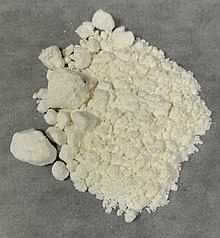Dinicotinic acid
| Structural formula | |||||||||||||||||||
|---|---|---|---|---|---|---|---|---|---|---|---|---|---|---|---|---|---|---|---|

|
|||||||||||||||||||
| General | |||||||||||||||||||
| Surname | Dinicotinic acid | ||||||||||||||||||
| other names |
Pyridine-3,5-dicarboxylic acid |
||||||||||||||||||
| Molecular formula | C 7 H 5 NO 4 | ||||||||||||||||||
| Brief description |
white fine crystalline powder |
||||||||||||||||||
| External identifiers / databases | |||||||||||||||||||
|
|||||||||||||||||||
| properties | |||||||||||||||||||
| Molar mass | 167.10 g mol −1 | ||||||||||||||||||
| Physical state |
firmly |
||||||||||||||||||
| Melting point |
320-325 ° C |
||||||||||||||||||
| pK s value |
pK s 1 (25 ° C) = 2.82 |
||||||||||||||||||
| solubility |
|
||||||||||||||||||
| safety instructions | |||||||||||||||||||
|
|||||||||||||||||||
| As far as possible and customary, SI units are used. Unless otherwise noted, the data given apply to standard conditions . | |||||||||||||||||||
Dinicotinic acid ( pyridine-3,5-dicarboxylic acid ) is an organic compound that belongs to the group of heterocycles (more precisely: heteroaromatic compounds ). It belongs to the group of pyridinedicarboxylic acids and consists of a pyridine ring that has two carboxy groups in the 3- and 5-positions. The name is derived from nicotinic acid ( pyridine-3-carboxylic acid ), which has only one carboxy group in the 3-position on the pyridine ring .
Extraction and presentation
The compound is formed when pyridine tetracarboxylic acid or carbodinicotinic acid is heated .
properties
Dinicotinic acid is sparingly soluble in water and ether. It melts at 323 ° C and thus has the highest melting point of all pyridinedicarboxylic acids. When melted, it decarboxylates and decomposes into nicotinic acid :
The compound has a monoclinic crystal structure with the space group P 2 1 / c (space group no. 14) .
Individual evidence
- ↑ a b c d e data sheet dinicotinic acid (PDF) from Merck , accessed on December 27, 2013.
- ^ D'Ans-Lax: Pocket book for chemists and physicists , 3rd edition, Volume 1, Springer-Verlag, Berlin-Göttingen-Heidelberg 1967 ( ChemieOnline - pK b and pK s values ).
- ^ William M. Haynes: CRC Handbook of Chemistry and Physics, 96th Edition . CRC Press, 2015, ISBN 978-1-4822-6097-7 , pp. 474 ( limited preview in Google Book search).
- ↑ a b c Richard Wolffenstein : The plant alkaloids . Springer-Verlag, 2013, ISBN 978-3-642-92449-1 , pp. 67 ( limited preview in Google Book search).
- ↑ Hans Meyer, Hans Tropsch: About dinicotinic acid and its degradation to ββ′-diaminopyridine and about αα′-diaminopyridine. In: Monthly magazine for chemistry . 35, 1914, pp. 207-217, doi : 10.1007 / BF01518124 .
- ^ J. Trotter: Structure Reports Organic Section . Springer Science & Business Media, 2013, ISBN 978-94-017-3121-8 , pp. 174 ( limited preview in Google Book search).


